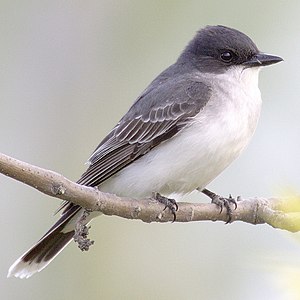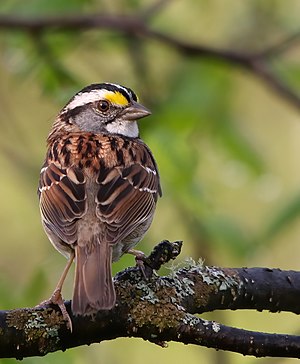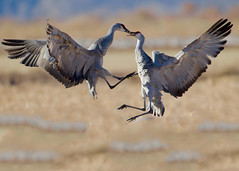I took advantage of milder days during winter and early spring to teach new assistants the fine art of bird extraction from mist nets at my feeder. I hoped to capture some birds we never see in our nets on Wing Island, such as Pine Siskins and Common Redpolls. On 2 March, 23 birds of 10 species were handled with just 1 1/2 nets open for 2 hours in late afternoon. Two chickadees were recaptures from last year and the rest were new birds. I was fortunate to capture 3 redpolls. What handsome birds!
I had hoped for the possibility of a Hoary Redpoll to be in the flock but no such luck. The longer and more acutely angled bill shown below
and streaked undertail coverts
along with heavily streaked back pointed towards Common Redpoll. Bill lengths were long too compared to Hoary.
Five Downy Woodpeckers were banded this day, with 4 being SY (second year) birds.
The last Downy, however, appeared with 2 isolated juvenal looking primary coverts (first and third from the outside) indicating a possible 4Y (fourth year) bird, but I will likely age it as an ATY (after third year) bird for the banding lab.
Eastern Bluebirds have been busy chowing down on my 'birdy bread pudding' made from a mix of lard, chunky peanut butter, and cornmeal including this SY female. She had a molt limit in the greater coverts (those feathers in the middle of her wing), molting the inner 4 feathers and retaining the rest.
Another clue to her age as a SY bird is the retained juvenal outermost primary covert which presents with wide white edging around the feather.
Pine Siskins were seen frequently during the winter at the feeders but I only captured one on 15 March.
Net lane maintenance and mist net installation occurred between 14 - 19 April. Many thanks to Judith Bruce, Suzanne Faith, Stew & Margo Goodwin, Carolyn Kennedy, and Gretchen Putonen for helping out. Our first day banding back on the island was 4/21 with 42 birds of 10 species handled. The majority of those were Black-capped Chickadees, 33 in all, and most banders would agree that chickadees can give us a run for our money being as feisty as they are! We banded another 13 chickadees the next day, the most we've ever banded in the course of two days. It must have been a small migrating group since 29 of them were full of fat.
Three of the chickadees presented with leucistic feathers, those lacking melanin, one with leucistic secondary flight feathers, one with the outermost tail feather on each side, and one with half of the tail leucistic. This bird had lost half of the tail and may have undergone some stress as it's new feathers were growing in.
This Tufted Titmouse, in the same family as the chickadee, Paridae, looks quite innocent as I took the picture, but certainly didn't appreciate the banding process, squawking and biting me the whole time!
One lonely junco showed up in the mix, a handsome ASY (after second year) male.
This beautiful ASY male Eastern Towhee with it's gorgeous red eyes, sung the whole time I banded it, what a treat for me!
Judith was so happy to capture her first Tree Swallow, a species we occasionally band. This bird was eager to get back to its mate, wings flapping repeatedly as I tried to take a picture, so I put him in the bander's grip and settled for a face pose.
Thanks to Judith Bruce, Stew and Margo Goodwin, and Ron Hunter for helping with the banding the past two days. Rain is coming in so hopefully I'll get back to the nets soon. Birds seen, heard, or captured on 21-22 April are shown below. Of the total birds handled, 14 were recaptures from previous years, the oldest being a 3 yr old chickadee and Blue Jay. Numbers reflect captured birds only.
Total Birds: 65 Total Species: 38
Total Banded Species: 10 Birds/100 net-hours: 44
| Double-crested Cormorant | |
| Great Blue Heron | |
| Canada Goose | |
| Osprey | |
| Red-tailed Hawk | |
| Greater Yellowlegs | |
| Laughing Gull | |
| Herring Gull | |
| Lesser Black-backed Gull | |
| Great Black-backed Gull | |
| Mourning Dove | |
| Belted Kingfisher | |
| Downy Woodpecker | |
| Yellow-shafted Flicker | |
| Eastern Phoebe | |
| Tree Swallow | 1 |
| Blue Jay | 1 |
| American Crow | |
| Fish Crow | |
| Black-capped Chickadee | 46 |
| Tufted Titmouse | 4 |
| White-breasted Nuthatch | |
| Golden-crowned Kinglet | |
| American Robin | 1 |
| Northern Mockingbird | |
| Cedar Waxwing | |
| European Starling | |
| Pine Warbler | |
| Northern Cardinal | 3 |
| Eastern Towhee | 1 |
| Song Sparrow | 5 |
| White-throated Sparrow | |
| Dark-eyed Junco | 1 |
| Red-winged Blackbird | |
| Common Grackle | |
| Brown-headed Cowbird | |
| American Goldfinch | 2 |
| House Sparrow | |



















































